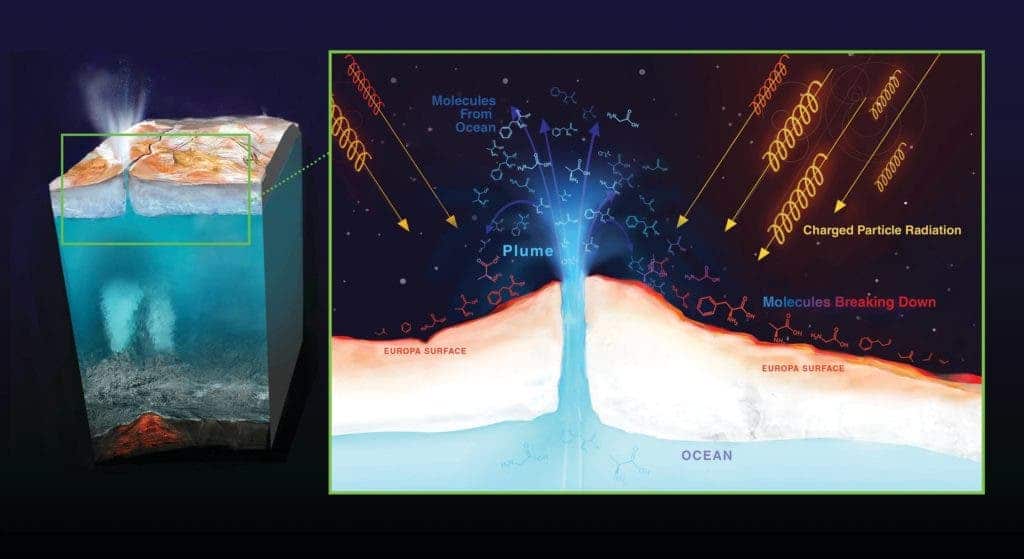Life may be tantalizingly close to Europa’s surface — just deep enough to be hidden from us, but close enough that mere scratches could bring it to the surface.

As far as alien life is concerned, Europa doesn’t seem like a particularly attractive place, at least at a first glance. Jupiter’s frozen moon seems like a small, barren world, too far away from the Sun to draw any interest. But modern science has found that beneath Europa’s frigid surface, there almost certainly lies an ocean of liquid water — an ocean of water believed to be in direct contact with the satellite’s core, which could lead to intriguing chemical reactions that favor the development of life. We already know from thermal vents on Earth that ecosystems can form without energy from the sun, relying on chemical and thermal energy from the depths of the ocean.
Could this also be the case on Europa?
Well, astronomers already suspect that plumes of water and gas could contain the biosignatures of life, but then again — so might the surface of Europa itself. In a new study addressing this issue, researchers explain that if these signatures exist, they may very well be close to the surface — they just need to survive the intense radiation pummeling from Jupiter, which can destroy or alter material transported up to the surface.
“Our results also show that amino acids, although heavily reduced in concentration, would persist at detectable levels … over 10 million year timescales at 10 centimeter depths even in the harshest radiation environments on the surface of Europa,” the researchers write in the paper, published today in Nature Astronomy.

They published a new comprehensive map detailing this radiation. As scientists are trying to see what the best places to search for life are, this type of map can be extremely useful for deciding where not to look. The lead author Tom Nordheim, research scientist at NASA’s Jet Propulsion Laboratory, Pasadena, California, explains that understanding how radiation acts on Europa is vital for this search for alien life.
“If we want to understand what’s going on at the surface of Europa and how that links to the ocean underneath, we need to understand the radiation,” Nordheim said. “When we examine materials that have come up from the subsurface, what are we looking at? Does this tell us what is in the ocean, or is this what happened to the materials after they have been radiated?”
Nordheim and colleagues found that radiation-surviving amino acids could hide as close as 10 cm beneath the surface — a mere scratch away — though in reduced concentrations. If they want to increase their odds of finding life, astronomers should go further from Europa’s equator, towards its higher latitudes — where the moon points away from Jupiter. Furthermore, they should look for “young” ice, no older than 10 million years.
Of course, this is all based on a huge hypothetical: the idea that life on Europa does exist — something which we have no information about and are only theorizing at the moment. But the study comes right in time, as both NASA and the ESA aim to send life-searching shuttles to Europa in the not-so-distant future: the early 2020s.
The so-called Europa Clipper mission from NASA will explore the habitability of Europa, and tell its sister mission, the Europa Lander, where to look for signs of life. Meanwhile, JUICE (JUpiter’s ICy moon Explorer) will perform detailed investigations on Ganymede — another Jovian moon similar to Europa — and will also carry out investigations of Europa.
These missions would both benefit from this radiation map.
“The radiation that bombards Europa’s surface leaves a fingerprint,” said Kevin Hand, co-author of the new research and project scientist for the potential Europa Lander mission. “If we know what that fingerprint looks like, we can better understand the nature of any organics and possible biosignatures that might be detected with future missions, be they spacecraft that fly by or land on Europa.”
Journal Reference: T. A. Nordheim et al. Preservation of potential biosignatures in the shallow subsurface of Europa, Nature Astronomy (2018). DOI: 10.1038/s41550-018-0499-8


